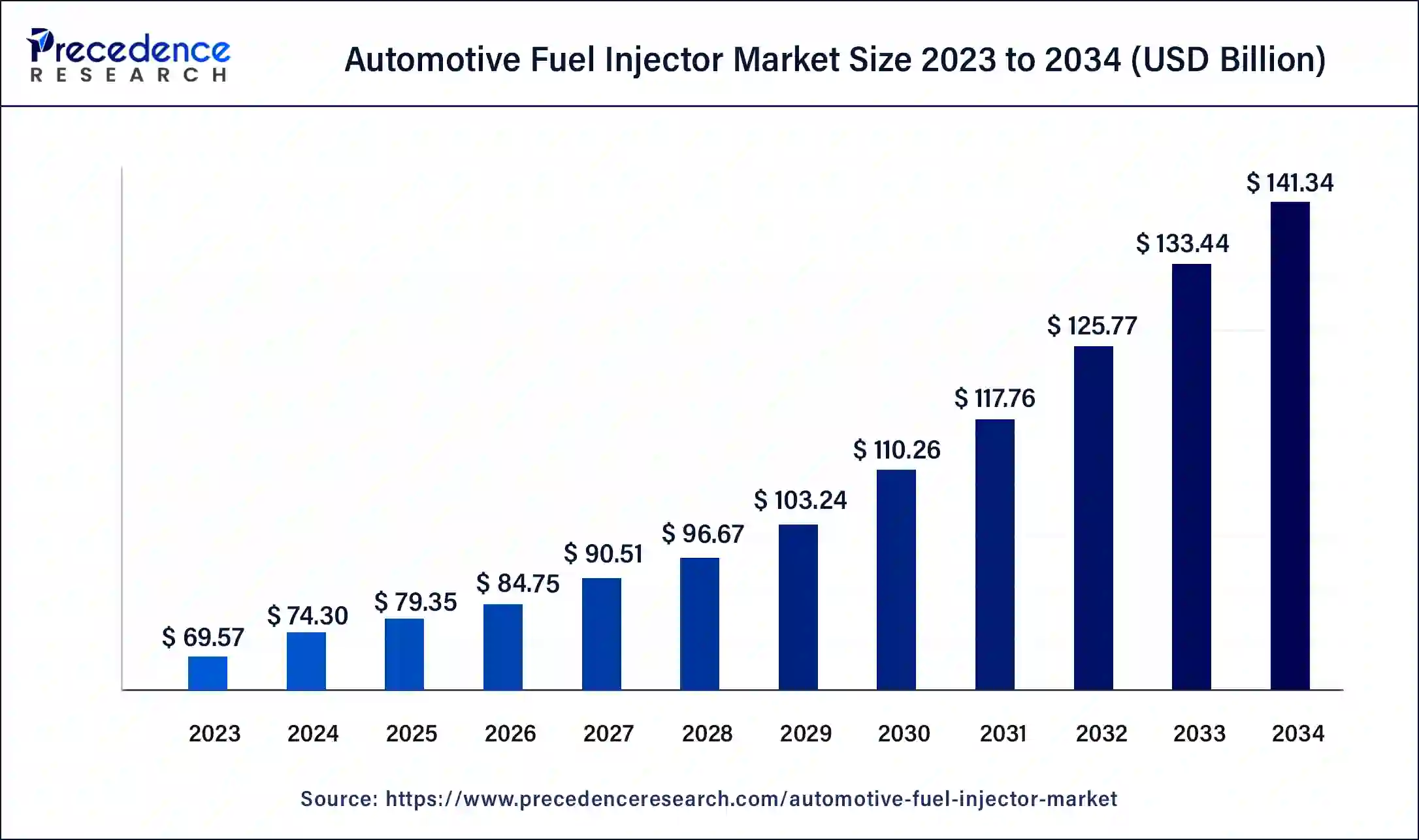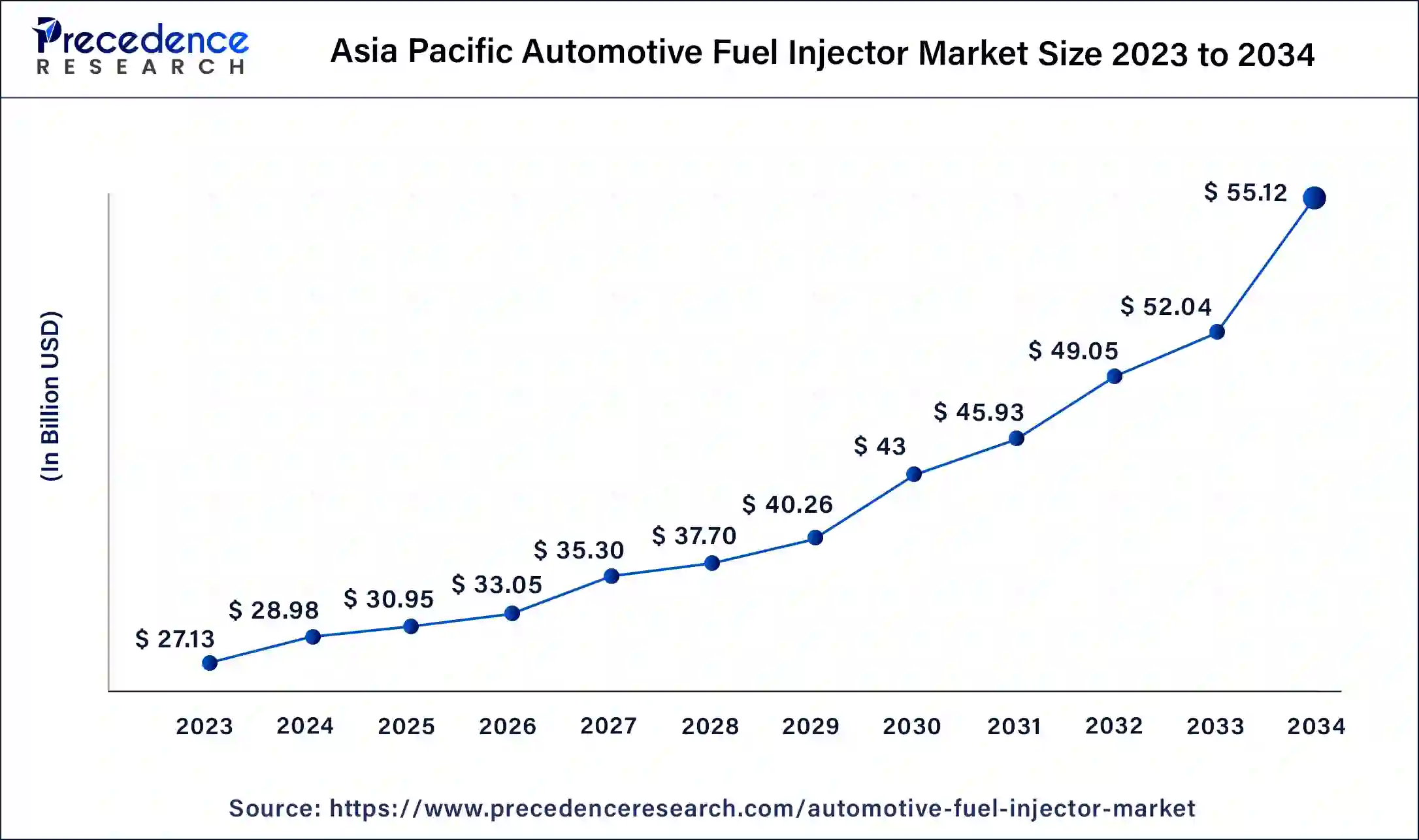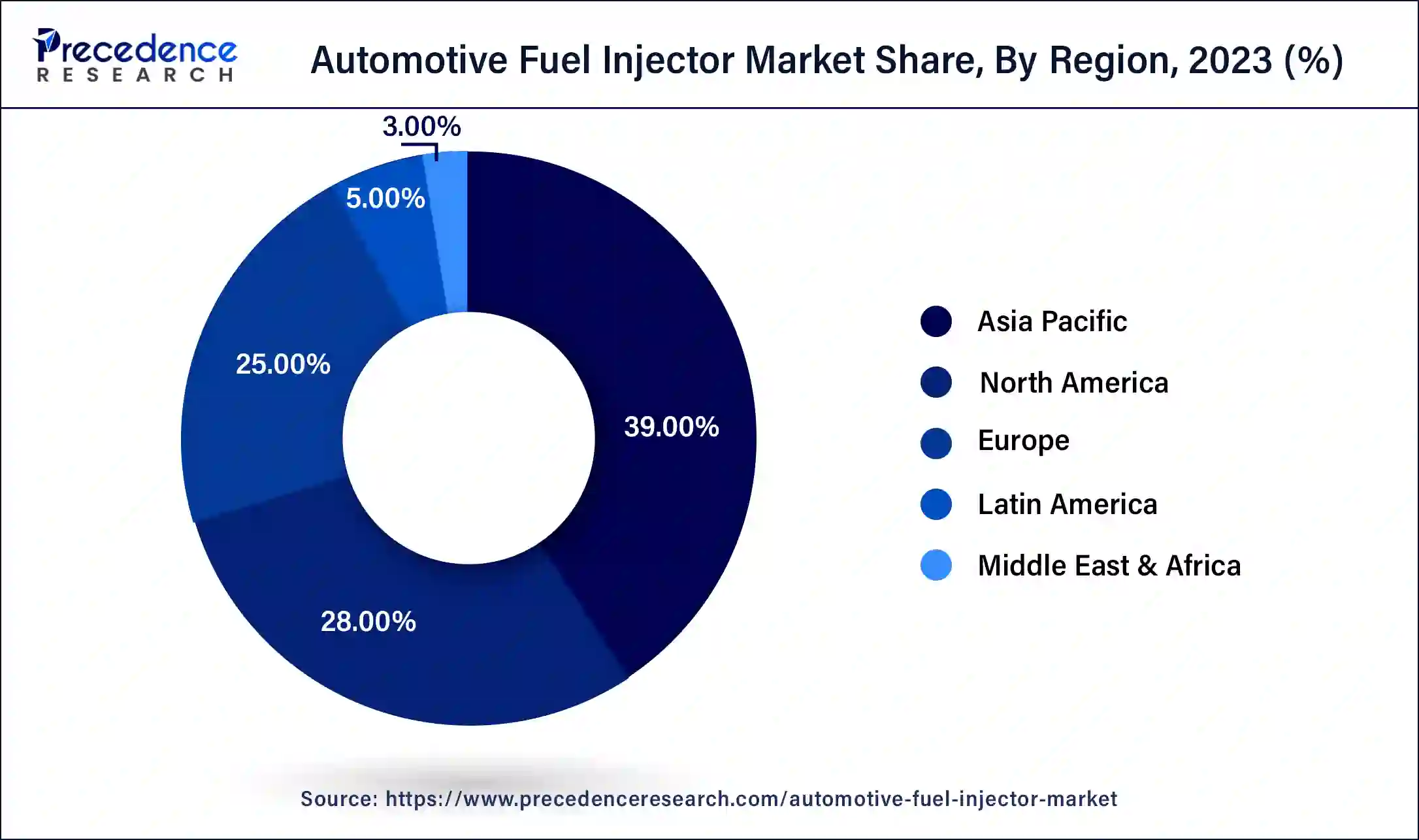January 2025
The global automotive fuel injector market size is calculated at USD 79.35 billion in 2025 and is forecasted to reach around USD 141.34 billion by 2034, accelerating at a CAGR of 6.64% from 2025 to 2034. The North America market size surpassed USD 28.98 billion in 2024 and is expanding at a CAGR of 7.00% during the forecast period. The market sizing and forecasts are revenue-based (USD Million/Billion), with 2024 as the base year.
The global automotive fuel injector market size accounted for USD 74.30 billion in 2024 and is predicted to reach around USD 141.34 billion by 2034, expanding at a CAGR of 6.64% from 2024 to 2034.

The global automotive fuel injector market size was estimated at USD 74.30 billion in 2024 and is predicted to increase from USD 79.35 billion in 2025 to approximately USD 141.34 billion by 2034, expanding at a CAGR of 6.64% from 2025 to 2034.

The Asia Pacific witnessed the leading value share across the global market as well as encountered to be the fastest growing region over the analysis timeframe. The growth of the region is mainly attributed to the increasing automotive production in the region. In addition, demand for high fuel efficient vehicles, growing purchasing power, and enforcement of stringent emission norms in developing nations that include Thailand, China, and India are the other key factors that has prominently propelled the demand for fuel injection system in the region.

Besides this, North America registers notable rise in the demand for fuel injection system in the commercial vehicles due to prominent increase in the e-commerce business along with rapid growth in the transportation & logistics business.
The increasing demand for automotive fuel injector is primarily governed by the global vehicle production. Improved power output & fuel efficiency as well as stringent laws for carbon emission are some of the other key factors that drive the demand for fuel injection systems in the automotive industry. Rising demand for two-wheelers in the countries that include India, China, and Brazil creates new growth prospects for the fuel injection system. The overall demand of fuel injection system expected to grow at a promising rate in the years to come.
Rising concerns for increasing fuel prices &various environmental regulations, fuel efficiency, and vehicle exhaust gases have influenced the companies operating in the automotive industry to look for alternative technology. Around 23% of the total environmental pollution is contributed by the transportation sector. In addition, with an alarming rate of increase in air pollution has forced governments of different regions to take strict actions to curtail its growth rate. In the wake of same, improved fuel efficiency is one of the prime factors to regulate the emission rate.
Furthermore, depleting layer of natural resources has significantly stimulated the fuel prices, thereby triggering the demand for high fuel efficiency and simultaneously the growth of automotive fuel injector market. Besides this, increasing demand for electric and hybrid vehicles expected to hamper the growth of automotive fuel injector, as the vehicle drivetrain is completely dependent on the battery power source.
| Report Highlights | Details |
| Market Size in 2034 | USD 141.38 Billion |
| Market Size in 2025 | USD 79.35 Billion |
| Market Size by 2024 | USD 74.30 Billion |
| Growth Rate from 2024 to 2034 | CAGR of 6.64% |
| Largest Market | Asia Pacific |
| Fastest Growing Region | North America |
| Base Year | 2024 |
| Forecast Period | 2025 to 2034 |
| Segments Covered | Vehicle Type, Pressure Range, Mounting, Fuel Injected, Type of Nozzle, Activating Source, Sales Channel, Regional Outlook |
| Regions Covered | North America, Europe, Asia-Pacific, Latin America, and Middle East & Africa |
Based on mounting, the global automotive fuel injector market is bifurcated into central port injector, throttle body injector, and multiport & direct fuel injector. Among them, multiport & direct fuel injector is widely preferred in most of the diesel and gasoline engines as it directly injects the fuel inside the cylinder. It is an advanced injection technology that enhances the fuel/air ratio that enters into an engine of a vehicle. In addition, this technology of fuel insertion results in improved performance of the vehicle along with reduced fuel consumption and emissions, all in cost-effective manner. As a result, the technology has gained significant traction over the past few years as the concern for environmental pollution has risen beyond the safety limits.
Passenger vehicles led the global automotive fuel injector market owing to its high production rate. Besides of the fact that the automotive industry registered sluggish growth in its sales volume, the demand for passenger vehicles expected to flourish in the coming years because of introduction to new and advanced technologies in the vehicle, ageing of vehicles, and stringent regulation to cut the emission rate.
On the other hand, commercial vehicles expected to witness profound growth over the forecast period attribute to the flourishing growth of e-commerce and retail business. Furthermore, shifting preference of consumers for online purchasing expected to escalate the demand for transportation & logistics during the same period.
The global automotive fuel injector industry witnesses significant investment in research & development (R&D) activity from several manufacturers. To provide optimum and cost-effective technology with significant benefits in terms of fuel efficiency propel industry players to invest prominently in the R&D sector. This also helps the market players to maintain their competitive edge in the global market. The market also seeks numerous collaborations, partnerships, and joint ventures with automotive manufacturers to deploy the technology in their new models or cars.
This research study comprises complete valuation of the market revenue with the help of widespread quantitative and qualitative insights, and prognoses of the market. This report presents breakdown of market into forthcoming and niche segments. Additionally, this research study gauges market revenue growth and its drift at global, regional, and country from 2024 to 2034. This report includes market division and its revenue assessment by categorizing it based on vehicle type, pressure range, mounting, fuel injected, type of nozzle, activating source, sales channel, and region:
By Vehicle Type
By Pressure Range
By Mounting
By Fuel Injected
By Type of Nozzle
By Activating Source
By Sales Channel
By Regional Outlook
For inquiries regarding discounts, bulk purchases, or customization requests, please contact us at sales@precedenceresearch.com
No cookie-cutter, only authentic analysis – take the 1st step to become a Precedence Research client
January 2025
April 2025
January 2024
January 2025